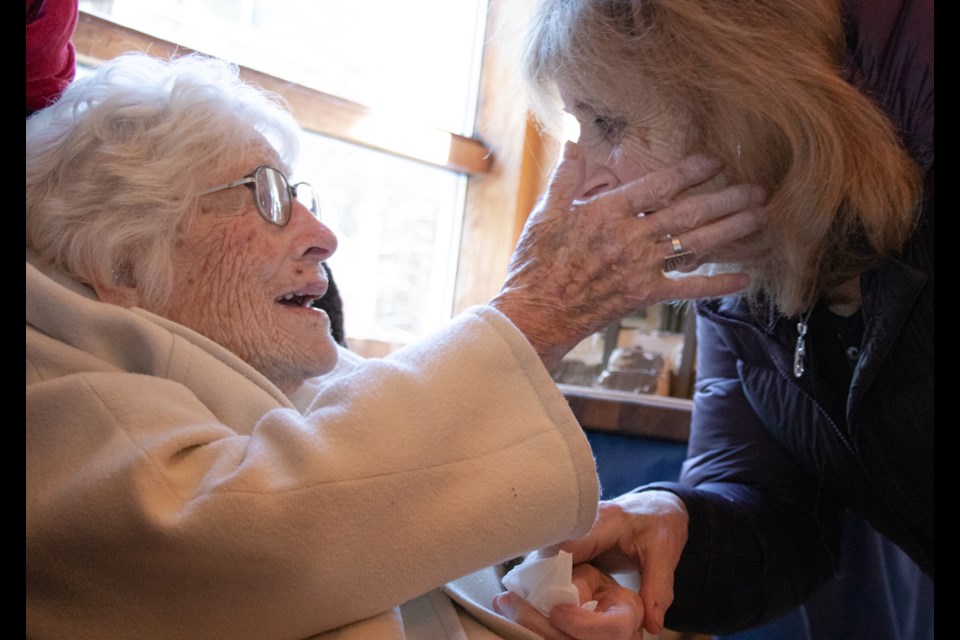On the same land where she was born, metres from where she was married and under the gaze of her parents’ portraits, Jean Jamieson celebrated her hundredth birthday Feb. 9.
At the birthday party at Collins’ Hall, generations of the Collins family (Jamieson was born a Collins), friends and islanders serenaded the 1996 citizen of the year with happy birthday and added their congratulations to the guest book placed near the letters from the Queen and Governor General.
Memories come slowly to the islander these days, after all, she has many to sort through, but a mischievous spark still glows in her eyes.
I’m visiting Jamieson at her Collins Rd. home a few days after her centennial birthday.
Jamieson’s sole roommate in the house she and her late husband Stuart moved into in the mid-1980s, is Felix the cat. Homecare workers come throughout the day to help Jamieson and her daughters visit.
I’ve come to ask, what’s it like being 100––a milestone few of us will reach?
“It’s a bit unreal,” she says.
“Being 100 years doesn’t really mean much to me.” A chuckle.
My knees are nestled right up to the foot of Jamieson’s semi-reclined easy chair, my arm pushed up against a table full of birthday notes and cards. I have to face Jamieson and lean in as she’s now hard of hearing but she can read lips.
Over the course of an hour and a half, with some help from Jamieson’s daughters Karen and Laura, we discuss her life––the moments that stand out over a century.
This was a woman who was born before the Little Red Church was built (by her father and uncle) and who went to the first school on Bowen (taught for some time by her older sister Margaret). Her parents, James and Irene Collins, had a 167-acre farm on Bowen and seven children (Jean was fifth). The farmhouse that the Collins moved into when Jamieson was just three is still standing, though much of the original property has long-since been divvyed up. Jamieson’s house stands on a portion of the former property. After school every day, Jamieson and her sisters would roam the island looking for the cows that were milked and let out in the mornings.
To finish high school, Jamieson moved to Vancouver, working for room and board, and then in the early 1940s went on to live in a working girls co-op, founded by her future mother-in-law, suffragist and Vancouver Centre MLA Laura Marshall Jamieson. For some time, Jean Jamieson worked as a telephone operator.
One day, Jamieson biked from Vancouver to Horseshoe Bay and back on an old clunker bicycle, only to return to the co-op, hair in disarray, to meet the economist (at that time working in a war position in Ottawa) whom she would marry only weeks later at the Bowen Island United Church.
She raised four girls––Anne Marie, Karen, Marion-Lea and Laura––in Burnaby and then Kerrisdale and went back to school for a degree in teaching and then counselling when her youngest was 11 or 12. The Jamiesons would take their children on the road all over B.C. for Stuart’s research––by then he was a University of British Columbia professor. But once Stuart retired, the couple returned to the island.
However, the present seems to capture more of Jamieson’s attention than the past. “Isn’t it awful? These things fade into the background,” she says as her daughters fill in parts of her story.
On Bowen, Jamieson is well known for rousing a dedicated crew of islanders to attempt to buy the Cape Roger Curtis lands for $16 million back in 2004.
“I remember so all you talked about for years was Cape Roger Curtis,” Karen tells her mother.
“Oh how boring,” says Jamieson.
“No, it wasn’t boring,” responds Karen. “You guys worked really hard to try to turn that around.”
Sue Ellen Fast met Jamieson when she (Fast) was a staff person for Crippen Regional Park and Jamieson was one of the forces behind the Bowen Island Heritage Preservation Association, dedicated to preserving the Davies Orchard cottages and history (a history Jamieson had experienced first-hand.) Years ago Fast also helped Jamieson and her younger sister Marion Moore, now too in her late 90s, turn some of the old farm back into a market garden––the garden has now been a community-supported agriculture project for more than a decade. But the Cape years stand out for Fast.
“Jean’s kitchen table was a key place where people came together with their hearts and their ideas and their energy to begin this huge project of trying to preserve Cape Roger Curtis for the future and for the island and for the nature,” she said.
Jamieson was such an inspiration for Fast that she had Jamieson and Moore as the first and second signatures on her nomination papers when she ran for council the first time.
“Keep as much of Bowen natural as possible,” Jamieson remembers after Karen reminds her how much effort went into the cape.
But the obligatory question for anyone turning 100 is if they have any words of wisdom to share with rest of us.
“I don’t think I really have,” says Jamieson. “It would be rather patronizing I think.”
Karen asks how Jamieson feels about all the changes she’s seen on Bowen.
“I don’t think it has disturbed me particularly,” says Jamieson. “It’s still my island.”



